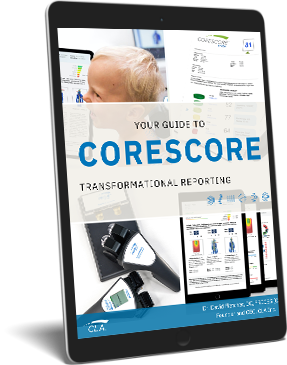Set the direction for your care plan
When you are driving on unfamiliar roads it’s always reassuring to see road signs that confirm you’re headed in the right direction. That’s how patients feel when they are working through their care plan. Re-exams and their updated reports are like magical road signs that reassure and confirm that everything is going as planned.
We surveyed thousands of offices using the INSiGHT and they told us that their biggest retention and referral strategy was taking the time to highlight a patient’s progress, compare the ongoing results and continue to provide trusted advice based on objective data. We listened and built the CORESCORE sequence into our Synapse software so that you can effortlessly keep your patients informed and inspired.
The initial CORESCORE
Set the stage with the Initial CORESCORE for this sequence. We recommend choosing a reasonable number of visits between exams to allow time for the neuroplastic shift to. It’s typical and convenient to schedule the re-exams at the end of each block of 12 visits but you can choose whatever makes most sense in your approach.
Tips for CORESCORING
Here are a few tips to remember when setting up a care plan:
- The nervous system never stops learning, but it takes time to break old habits.
- A minimum of THREE exams is necessary to get an accurate perspective on what is trending:
- The INITIAL exam sets a benchmark to measure against
- The PROGRESS exam shows what is and isn’t changing
- The COMPARATIVE exam confirms what is trending
The Synapse software automatically sequences the reporting after the INITIAL CORESCORE into PROGRESS CORESCORE reporting, followed by a COMPARATIVE CORESCORE and then ongoing CONTINUATION CORESCORES. Each report is based on the patient’s actual data from that exam with a narrative relating to their results being pulled from an interpretation library.
This sequence was designed to use the “sign post” model of informing the patient where they are and where they are going. We all know the value of reporting is only as good as the way it is delivered. For example, when we created the Children’s CORESCORE we developed narratives that spoke directly to the parents about their child’s results. Needless to say, this has been a huge advancement in building trust and huge family practices!
Check out the CORESCORE reports
Dig in and get a feel for sample CORESCORE reports. You’ll see that they aren’t cookie cutter reports that speak in general terms. They are specific to the patient at that point in their care plan. Sometimes even best laid plans get interrupted by accidents, incidents or long breaks in care. The sequence is adaptable. You can reassign an exam to restart the sequence at any time.
Using the CORESCORE streamlines the entire care planning process by blending clinically accurate data with intuitive reporting and preset “sign posts”.
David
























































































































































